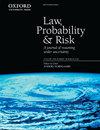经典概率与法律案件中的置信函数
IF 1.4
4区 社会学
Q1 LAW
引用次数: 0
摘要
我批判性地讨论了Nance最近提出的一个建议(信念函数和举证责任。法律,概率和风险,18:53-762018),该建议涉及在刑事或民事案件中使用信念函数而不是经典概率时,哪些信念比例是合适的。在这种情况下,我不质疑信念函数本身的使用,我同意Nance(信念函数和举证责任。法律,概率和风险,18:53-761018)中的观点,即在信念函数框架下可能的所谓“非承诺支持”不应在决策理论框架中考虑。然而,我在Nance(信念函数和举证责任。法律,概率和风险,18:53-762018)中反对,至少在刑法中,信念的相对大小根本不应该用于决策。我认为,应该只考虑个人的绝对信仰。由于置信函数概括了经典概率,乍一看,这一立场似乎与我们在法律背景下使用经典概率时几率很大的事实相冲突。那么,我将借此机会指出,同样在古典环境中,赔率也不是我们主要关心的问题。它们很方便,因为它们与似然比一起出现在贝叶斯规则的赔率形式中。除此之外,它们没有任何个人意义。我还注意到,在民法中,结论可能有所不同。本文章由计算机程序翻译,如有差异,请以英文原文为准。
Classical probabilities and belief functions in legal cases
I critically discuss a recent suggestion in Nance (Belief Functions and Burdens of Proof. Law, Probability and Risk, 18:53–76, 2018) concerning the question which ratios of beliefs are appropriate when in criminal or civil cases one works with belief functions instead of classical probabilities. I do not call into question the use of belief functions themselves in this context, and I agree with in Nance (Belief Functions and Burdens of Proof. Law, Probability and Risk, 18:53–76, 2018) that so-called ‘uncommitted support’, possible in the framework of belief functions, should not be taken into account in a decision-theoretic framework. However, I argue against in Nance (Belief Functions and Burdens of Proof. Law, Probability and Risk, 18:53–76, 2018) in that, at least in criminal law, relative sizes of beliefs should not be used for decision-making at all. I will argue that only the individual, absolute beliefs should be considered. Since belief functions generalize classical probabilities, this position seems at first sight to conflict with the fact that odds are abundant when we use classical probabilities in a legal context. I will take the opportunity, then, to point out that also in the classical setting, odds are not our primary concern either. They are convenient since they appear, together with the likelihood ratio, in the odds form of Bayes’ rule. Apart from that, they do not have any individual significance. I also note that in civil law the conclusions might be different.
求助全文
通过发布文献求助,成功后即可免费获取论文全文。
去求助
来源期刊

Law Probability & Risk
MATHEMATICSSTATISTICS & PROBABILITY&-STATISTICS & PROBABILITY
CiteScore
2.10
自引率
28.60%
发文量
8
期刊介绍:
Law, Probability & Risk is a fully refereed journal which publishes papers dealing with topics on the interface of law and probabilistic reasoning. These are interpreted broadly to include aspects relevant to the interpretation of scientific evidence, the assessment of uncertainty and the assessment of risk. The readership includes academic lawyers, mathematicians, statisticians and social scientists with interests in quantitative reasoning.
The primary objective of the journal is to cover issues in law, which have a scientific element, with an emphasis on statistical and probabilistic issues and the assessment of risk.
Examples of topics which may be covered include communications law, computers and the law, environmental law, law and medicine, regulatory law for science and technology, identification problems (such as DNA but including other materials), sampling issues (drugs, computer pornography, fraud), offender profiling, credit scoring, risk assessment, the role of statistics and probability in drafting legislation, the assessment of competing theories of evidence (possibly with a view to forming an optimal combination of them). In addition, a whole new area is emerging in the application of computers to medicine and other safety-critical areas. New legislation is required to define the responsibility of computer experts who develop software for tackling these safety-critical problems.
 求助内容:
求助内容: 应助结果提醒方式:
应助结果提醒方式:


